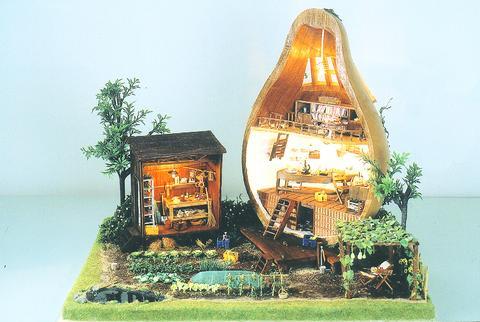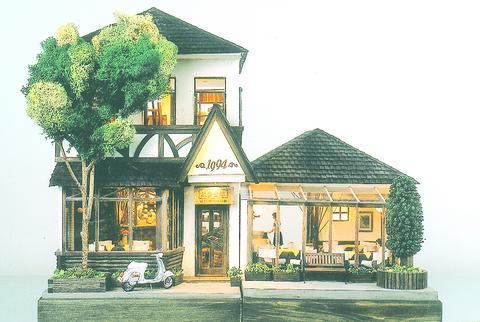The annual Doll's House Competition (
This year, the theme "dream workshop" has attracted a record number of entries. In the museum's current exhibition of winning works, 45 visualize the workplace of their dreams.
To encourage the use of different media in creating doll's houses, the museum has admitted only multi-media works in this year's competition. "We are happy to see there were so many submissions and they are also of the highest quality. The art of doll's house creation is finally taking off," said Lin Wen-ren (

PHOTO COURTESY OF MINIATURE MUSEUM OF TAIWAN
Contestants freely interpreted the meaning of "workshop." There are outdoor farming areas, kitchens, a butcher's shop and even wedding dress boutiques.
Lai Wan-yi (
"I made all the components in this doll's house by hand, because it is 1:24 in proportion to real size, ready-made parts on the market would not fit. The most difficult part was making the beans in the garden. They are really tiny," Lai said, pointing to some green beads on the model which the naked eye could hardly distinguish.

PHOTO COURTESY OF MINIATURE MUSEUM OF TAIWAN
Insisting on using real gourd for the gourd shape house in the model, Lai faced another challenge -- designing and fitting out the furniture and floors in an asymmetrical structure. After many attempts, Lai managed to make the floorboards fit the shape of the gourd and even installed extendable ladders.
All kinds of imagined concoctions are laid out on the table and books with real pages fill the shelves. Lai even bought and disassembled a microscope to make a miniature microscope, which has all the main components of the real thing.
Winner of the silver prize Lin Tzi-wei (
The attention to architectural details make his work stand out from other exhibits. It's also one of the few doll's houses with human figures, which Lin made with resin-added papier-mache.
Bronze-prize winner Wang Bao-ching (王寶慶) is one of the youngest winners. His antique shop is highly realistic, with graying front doors and a variety of delicate artifacts.

“Why does Taiwan identity decline?”a group of researchers lead by University of Nevada political scientist Austin Wang (王宏恩) asked in a recent paper. After all, it is not difficult to explain the rise in Taiwanese identity after the early 1990s. But no model predicted its decline during the 2016-2018 period, they say. After testing various alternative explanations, Wang et al argue that the fall-off in Taiwanese identity during that period is related to voter hedging based on the performance of the Democratic Progressive Party (DPP). Since the DPP is perceived as the guardian of Taiwan identity, when it performs well,

The Taiwan People’s Party (TPP) on May 18 held a rally in Taichung to mark the anniversary of President William Lai’s (賴清德) inauguration on May 20. The title of the rally could be loosely translated to “May 18 recall fraudulent goods” (518退貨ㄌㄨㄚˋ!). Unlike in English, where the terms are the same, “recall” (退貨) in this context refers to product recalls due to damaged, defective or fraudulent merchandise, not the political recalls (罷免) currently dominating the headlines. I attended the rally to determine if the impression was correct that the TPP under party Chairman Huang Kuo-Chang (黃國昌) had little of a

At Computex 2025, Nvidia CEO Jensen Huang (黃仁勳) urged the government to subsidize AI. “All schools in Taiwan must integrate AI into their curricula,” he declared. A few months earlier, he said, “If I were a student today, I’d immediately start using tools like ChatGPT, Gemini Pro and Grok to learn, write and accelerate my thinking.” Huang sees the AI-bullet train leaving the station. And as one of its drivers, he’s worried about youth not getting on board — bad for their careers, and bad for his workforce. As a semiconductor supply-chain powerhouse and AI hub wannabe, Taiwan is seeing

Jade Mountain (玉山) — Taiwan’s highest peak — is the ultimate goal for those attempting a through-hike of the Mountains to Sea National Greenway (山海圳國家綠道), and that’s precisely where we’re headed in this final installment of a quartet of articles covering the Greenway. Picking up the trail at the Tsou tribal villages of Dabang and Tefuye, it’s worth stocking up on provisions before setting off, since — aside from the scant offerings available on the mountain’s Dongpu Lodge (東埔山莊) and Paiyun Lodge’s (排雲山莊) meal service — there’s nowhere to get food from here on out. TEFUYE HISTORIC TRAIL The journey recommences with